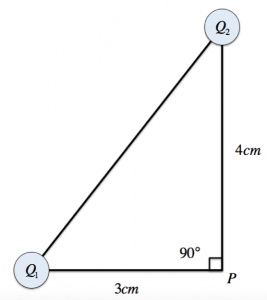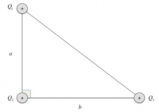[math]Q_1 = 6 \cdot 10^{-6} C [/math]
e [math]Q_2 = 8 \cdot 10^{-6} C [/math]
sono disposte come nella figura. Calcola il campo elettrico risultante nel punto [math]P[/math]
.Se le due cariche fossero immerse in un mezzo di costante dielettrica relativa
[math]ε_r = 2,5 [/math]
, quale sarebbe il valore del campo in [math]P[/math]
?

Svolgimento (1)
Il campo elettrico creato da[math]Q_1[/math]
è descritto dalla formula [math]E = k_0 \cdot frac(Q_1)(d_1 ^2) [/math]
e vale:
[math]E_1 = k_0 \cdot frac(Q_1)(d_1 ^2) = 8,99 \cdot 10^9 \cdot frac(6 \cdot 10^{-6} C )((0,03 m)^2) = 6,0 \cdot 10^7 N/C [/math]
Allo stesso modo, il campo creato da
[math]Q_1[/math]
risulta:
[math]E_1 = k_0 \cdot frac(Q_2)(d_2 ^2) = 8,99 \cdot 10^9 \cdot frac(8 \cdot 10^{-6} C )((0,04 m)^2) = 4,5 \cdot 10^7 N/C [/math]
Poiché i due campi sono perpendicolari, calcoliamo il campo risultante con il teorema di Pitagora:
[math] E = \sqrt{(E_1)^2 + (E_2)^2} = [/math]
[math] \sqrt{(6,0 \cdot 10^7 N/C)^2 + (4,5 \cdot 10^7 N/C)^2} = 7,5 \cdot 10^7 N/C [/math]
Svolgimento (2)
Se le due cariche fossero in un mezzo dielettrico di costante[math]2,5[/math]
, il campo sarebbe [math]2,5[/math]
volte minore; infatti la formula del campo elettrico diventerebbe:
[math] E = k_0 \cdot frac(Q)(d^2)= frac(1)(4πε_0 €_r) \cdot frac(Q)(d^2) [/math]
Quindi sarebbe:
[math] E_m = frac(7,5 \cdot 10^7 N/C)(2,5) = 3 \cdot 10^7 N/C [/math]



